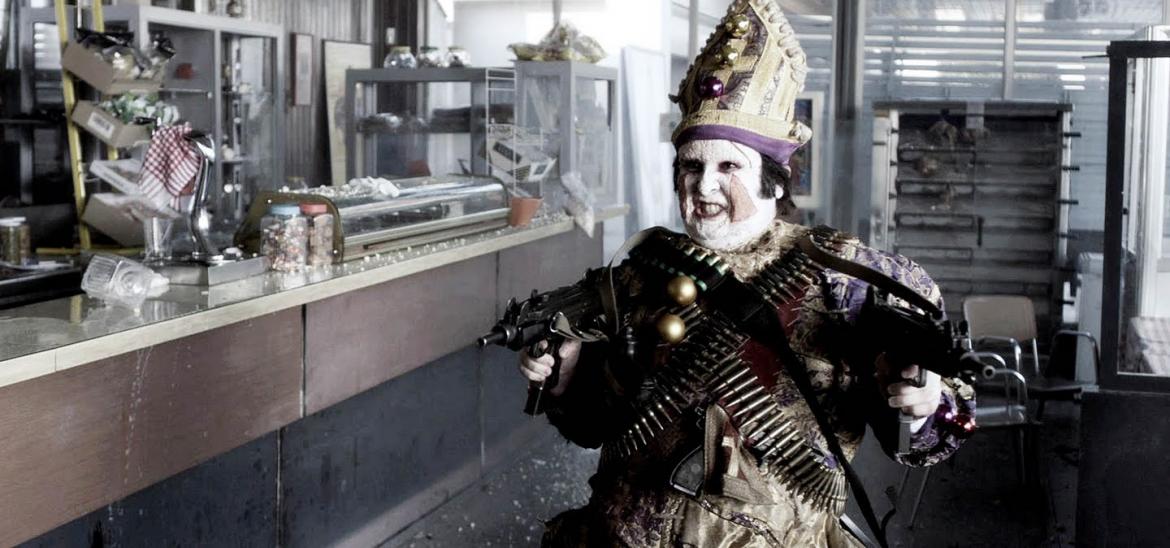
Balada triste de trompeta (The Last Circus) (Movie Review)
Álex de la Iglesia’s “Balada triste de trompeta” (Sad Trumpet Ballad) is a manic blend of old school horror images, some twisted humor, grotesque, audacious violence, a sprinkling of sex, and a deep interest in reconciling Spain’s national past with the countries contemporary orientation. More commonly known in the states as “The Last Circus”, the film is an exemplary rendition of a how a film can set out to be purposefully “cult” in its execution and still stay true to those roots. Unlike the rash of intentionally dated aesthetics, Grindhouse looking films, Iglesia is less concerned with making “The Last Circus” look like it comes from a certain period than he is in accomplishing a particular tone. Rather the film’s narrative and stylistic elements accomplish that unique balancing act of knowing how to represent itself as a product of a particular medium’s generic tradition and a story plucked from the filmmakers’ Spanish past.
It’s 1937 Madrid and the Spanish Civil War has been under way for nearly a year. As a Funny and Sad clown entertain a group of children bombs are heard dropping across the city, deafening the laughter with apprehensive silence. Soon the Funny Clown is forcibly recruited by a rebel militia and must leave his son Javier behind. Made to wear his outfit into battle (it will “scare the shit of them”), the Funny clown annihilates a large number of the opposition with a machete before being captured and forced into a labor camp. While there, Javier’s father warns the boy that he can never be a Funny clown like him or his other relatives as he has had his childhood stripped away from him. During an escape attempt orchestrated by Javier, his father is killed and Colonel Salcedo (Sancho Garcia) is left missing an eye.
26 years later the quiet, meek Javier (Carlos Areces) is the newly hired “Sad Clown” of a small circus. His counterpart “Happy Clown” Sergio (Antonio de la Torre) is a drunken, vicious and sadistic man who abuses his acrobat girlfriend Natalia (Carolina Bang) and intimidates the entire circus staff. Natalia and Javier cultivate a strange friendship in which neither Javier nor we are quite sure if Natalia is toying with him for her own personal pleasure. After finding the pair at a fair, Sergio goes mad with jealousy and beats Natalia and sends Javier to the hospital. Javier returns to the circus hoping to reunite with Natalia only to find her and Sergio having sex. Javier goes into a jealous rage, brutally beating Sergio with a trumpet and lacerating his face. As the film unfolds we watch as Javier continues his wacky descent into mad revenge while struggle with the demands of his passed and his struggle with the Franco’s government that was responsible for his father’s death.
“The Last Circus” is a film I appreciate for its commitment to the great excesses of cinema. Throughout the film Iglesias calls attention to the cathartic power of visceral entertainment as a means for coping with insurmountable political and social violence. That Javier is supposedly incapable of having a childhood after his father’s performance is interrupted alludes to the dangers of repressing emotional, visceral responses and the channeling of these into violence. As a social tradition nominally looked down upon, the circus then provides a space outside of respectable society where these physical responses (laughter, fear, arousal) are capable of being played out. Throughout the film voices laughing and crying are blended together in a way that makes the emotional content nearly indistinguishable.
But while “The Last Circus” has a marked interest in the ways in which we control our bodies and behaviors the film also works to make larger associations between its characters and the historical settings they inhabit. By beginning at the start of the Spanish Civil War and concluding a couple years before Franco’s reign ends Iglesias points to the ways in which particular historical moments inform Javier and Sergio’s characters. We can see Javier then as a citizen whose past is simultaneously haunting him but also absent in his supposed lost childhood. In this way Javier then becomes representative of a generation craving a particular kind of history denied them. Sergio on the other hand is a creature of total presence whose laughter, drunken violence, and rabid sexuality could be viewed as a generation completely content to live in blind hedonism.
If Sergio and Javier become Franco’s Spain and the repressed Modern Spain than Natalia is representative of the body of Spanish land in its topographic and archaic cultural forms. It’s a narrative stroke that while not entirely new does add some extra gravitas to the personal albeit far reaching struggle between Javier and Sergio. But by utilizing Natalia in this way, Igelisa seems to have difficulty reconciling her as a symbolic object and as an actual person with desires and a personality. Her constantly shifting behavior, desires, and manic personality while appropriate for the surrounding events becomes altogether tiresome and raises more than a few confusing questions and begins to bog the film down particularly in the second half.
That being said, “The Last Circus” is a truly raucous and grotesque piece of cult filmmaking that works well as a titillating and provocative piece of fun-art. And while it doesn’t quite land its attempts at bridging the gap between visceral manic violence and its more commonly interpreted “intellectual” pursuits, it does provide more than enough meat for multiple types of audiences to chew on.

